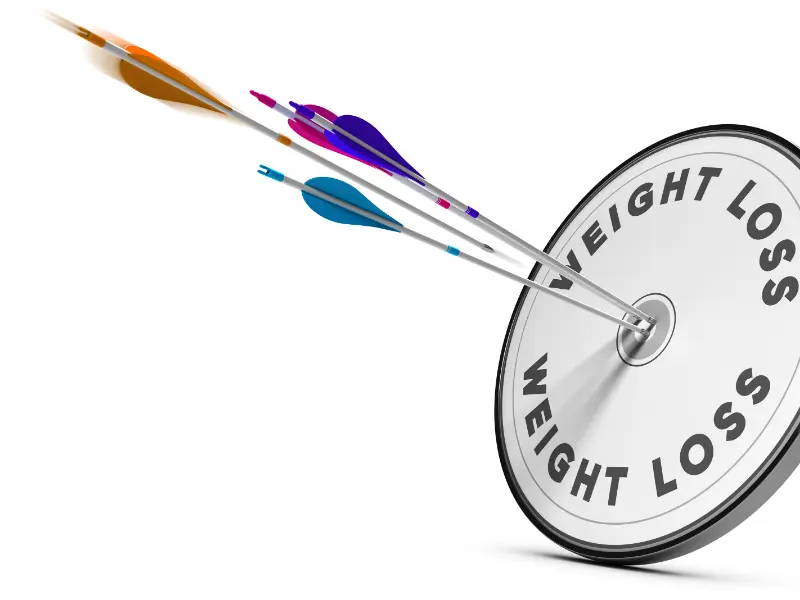Starting a weight loss journey can feel overwhelming, especially when motivation seems elusive. Many people struggle to find the internal drive needed to make consistently healthy choices day after day. The cycle of starting strong but losing steam is frustratingly common.
Finding sustainable motivation for weight loss requires understanding your personal “why” behind wanting to change. When you connect your goals to meaningful reasons—improving your health, having more energy for your family, or feeling more confident—you create a foundation for lasting commitment.
You don’t need to wait for motivation to magically appear before taking action. Sometimes, the process works in reverse: taking small, consistent steps creates momentum that builds motivation naturally.
Establishing simple habits and celebrating your progress creates a positive feedback loop that makes continuing your weight loss journey significantly easier.
Motivation and Weight Loss

Motivation is the driving force behind sustainable weight loss. It combines psychological, emotional, and behavioral elements that push you toward your goals even when faced with challenges.
Components of Motivation
Motivation for weight loss consists of both intrinsic and extrinsic factors.
Intrinsic motivation comes from within—like wanting to feel healthier or have more energy. This type of motivation tends to be more sustainable in the long term.
Extrinsic motivation involves external rewards or pressure, such as compliments from others or fitting into specific clothes. While potentially powerful initially, external motivators often diminish over time.
The most effective weight loss journeys combine both types. You might start with an extrinsic goal, like looking better for an event, but develop intrinsic motivation as you begin feeling stronger and more energetic.
Your motivation also relies on your self-efficacy—your belief in your ability to succeed. Past successes, even small ones, build this confidence and fuel continued progress.
Psychology Behind Weight Loss Motivation
Your brain processes motivation through its reward system. When you achieve small goals, your brain releases dopamine, creating positive feelings and reinforcing behavior.
This explains why immediate rewards often trump long-term benefits. Your brain values the instant pleasure of high-calorie foods over the delayed reward of weight loss.
Implementation intentions can help bridge this gap. Rather than vague plans like “eat better,” specific if-then strategies like “If I crave snacks at night, I’ll eat fruit instead of chips” are more effective.
The stages of change model identifies where you are in your readiness to lose weight:
- Pre-contemplation (not ready)
- Contemplation (considering change)
- Preparation (making plans)
- Action (actively changing)
- Maintenance (sustaining changes)
Understanding your current stage helps you tailor appropriate motivational strategies.
Barriers to Motivation
Perfectionism commonly undermines weight loss efforts. Expecting flawless adherence to diet and exercise often leads to giving up after minor slips.
Unrealistic expectations about weight loss speed or results can quickly deflate motivation. Most healthy weight loss occurs gradually at 1-2 pounds per week.
Your environment plays a crucial role, too. Easy access to unhealthy foods, sedentary workspaces, or unsupportive friends and family can sabotage your efforts despite strong initial motivation.
Emotional eating creates particularly challenging barriers. Many people use food to cope with stress, loneliness, or boredom, creating patterns that require new coping mechanisms to overcome.
Recognizing these obstacles allows you to develop targeted strategies rather than assuming a simple lack of willpower is to blame.
Setting Realistic Goals

Goal-setting forms the foundation of successful weight loss. When your goals align with your lifestyle and capabilities, you’re more likely to stay committed and see lasting progress.
SMART Goals for Weight Loss
Weight loss goals work best when they follow the SMART framework: Specific, Measurable, Achievable, Relevant, and Time-bound.
Instead of saying, “I want to lose weight,” try, “I will lose 8 pounds in 2 months by exercising 3 times weekly and reducing my sugar intake.”
Specific goals provide clarity about exactly what you want to accomplish. Measurability allows you to track your progress using numbers, such as pounds lost or inches decreased.
Achievable goals prevent the disappointment that comes with unrealistic expectations. Most health experts recommend losing 1-2 pounds per week as a sustainable rate.
Relevance matters because your goals should connect to your personal values and larger life objectives. Time-bound goals create productive urgency with clear deadlines.
Micro Goals and Milestones
Breaking your weight loss journey into smaller chunks makes the process less overwhelming. Micro goals act as stepping stones toward your ultimate target.
Consider creating weekly targets like “drink 64 oz of water daily” or “walk 7,000 steps daily.” These small victories build momentum and confidence.
Track your progress with milestones that celebrate specific achievements:
- First 5 pounds lost
- Completing a whole month of consistent exercise
- Fitting into a clothing item that was previously too tight
Milestones provide natural moments for reflection and reward. When you reach one, acknowledge your hard work before focusing on the next target.
Your micro goals should be concrete actions rather than results. Focus on behaviors you can control, such as preparing healthy meals or completing workouts, rather than the scale reading.
Developing a Positive Mindset
Your mindset plays a crucial role in weight loss success. How you think about yourself and your journey directly impacts your ability to stay consistent and overcome obstacles.
Overcoming Negative Self-Talk
Negative self-talk can sabotage your weight loss efforts before they begin. Notice when thoughts like “I’ll never lose weight” or “I always fail at diets” arise.
Challenge these thoughts with evidence from your past successes, even small ones. For example, replace “I always give up” with “I successfully walked three times last week.”
Keep a thought journal to track recurring negative patterns. Write down negative thoughts, then deliberately reframe them into more balanced statements.
Remember that setbacks are normal and don’t define your entire journey. Many successful weight loss stories include multiple attempts and learning experiences.
Quick exercise: When a negative thought appears, pause and ask yourself, “Would I say this to a friend?” If not, rephrase it with the same compassion you’d offer others.
Visualization Techniques
Visualization creates mental blueprints that help your brain recognize and move toward your goals. Spend 5-10 minutes daily imagining yourself at your goal weight.
Make your visualizations detailed and multisensory. Picture how your clothes feel, how your body moves with ease, and how confident you are in your posture.
Effective visualization practices:
- Create a mental movie of yourself successfully managing challenging situations
- Visualize yourself making healthy choices in previously difficult scenarios
- Imagine how you’ll feel after completing your workout (not just how you’ll look)
If appropriate, use photos of yourself from healthier times as visualization aids. Some successfully create a digital or physical vision board with images representing their goals.
Affirmations and Self-Encouragement
Affirmations work by replacing ingrained negative beliefs with positive alternatives. Create 3-5 personalized statements that feel believable and resonant.
Examples of effective affirmations:
- “I make choices that honor my health every day.”
- “I am becoming stronger with each healthy decision.”
- “My body deserves care and respect.”
Use present tense and positive language. Say, “I am becoming healthier,” rather than “I will stop being unhealthy.”
Repeat your affirmations during specific triggers, such as looking in the mirror, before meals, or when faced with temptation. Consistency matters more than length.
Celebrate small victories to build momentum. Acknowledge each workout completed, healthy meal prepared, or craving overcome with deliberate self-recognition.
Creating a Sustainable Plan

Developing a long-term weight loss plan requires careful consideration of diet, exercise, and behavioral factors. The most successful approaches balance realistic dietary changes with regular physical activity while addressing the psychological aspects of eating.
Balanced Dieting Strategies
Sustainable weight loss begins with a moderate calorie deficit of 500-750 calories daily, typically leading to 1-2 pounds of weight loss per week. Avoid extreme restrictions that can trigger rebound eating or nutrient deficiencies.
Focus on nutrient-dense foods that keep you satisfied longer. Include:
- Protein sources: Lean meats, fish, eggs, legumes (20-30% of calories)
- Complex carbohydrates: Whole grains, fruits, vegetables (45-55% of calories)
- Healthy fats: Avocados, nuts, olive oil (25-35% of calories)
Consider meal planning to avoid impulsive food choices. Prepare food in advance when your motivation is high to support yourself during challenging moments.
Track your food intake initially to understand your eating patterns. This doesn’t need to be permanent but can provide valuable insights for the first few months.
Incorporating Regular Exercise
Choose activities you genuinely enjoy rather than exercises you think you “should” do. Sustainability depends on finding a movement that feels rewarding.
Start small with 10-15 minutes daily, gradually building to the recommended 150 minutes of moderate activity weekly. This gradual approach prevents burnout and injury.
Mix cardio, strength training, and flexibility work for optimal results:
- Cardio (3-5 times weekly): Walking, swimming, cycling
- Strength (2-3 times weekly): Bodyweight exercises, resistance bands, weights
- Flexibility (daily): Stretching, yoga
Schedule exercise like any appointment. Morning sessions often have higher completion rates as willpower diminishes throughout the day.
Track your progress using metrics beyond the scale, such as increased energy, improved sleep, or greater strength.
Behavioral Changes for Long-Term Success
Identify your personal triggers for unhealthy eating patterns. Common triggers include stress, boredom, social pressure, and emotional distress.
Develop specific strategies for challenging situations:
- Stress management: Practice deep breathing, meditation, or brief walks
- Social eating: Review menus beforehand or eat a small healthy snack before events
- Emotional eating: Create a list of non-food coping mechanisms
Implement habit stacking by attaching new healthy behaviors to existing routines. For example, stretch for five minutes after brushing your teeth.
Celebrate non-scale victories regularly, rather than focusing exclusively on weight, and notice improvements in energy, mood, clothing fit, and physical capabilities.
Finding Your Support System

Weight loss becomes more achievable when you surround yourself with people who encourage your efforts and understand your journey. The proper support can provide accountability, motivation, and practical assistance when challenges arise.
The Role of Social Support
Family members and friends can significantly impact your weight loss journey. Research [1] shows that people with strong social support lose more weight and maintain their results longer than those who attempt to lose weight alone.
Consider telling close friends and family about your goals. Be specific about how they can help—whether by joining you for walks, respecting your food choices, or simply checking in on your progress.
Your partner’s support is particularly valuable. When a couple commits to healthier habits together, success rates improve dramatically.
Key support behaviors to request:
- Positive reinforcement rather than criticism
- Practical help with meal preparation
- Exercise companionship
- Understanding during difficult moments
Professional Help and Coaching
Working with professionals can provide structured guidance tailored to your specific needs.
A registered dietitian can help create a sustainable eating plan based on your preferences and lifestyle requirements.
Personal trainers design effective workout routines while teaching proper form to prevent injury.
Many offer in-person and virtual options to fit your schedule and comfort level.
Health coaches focus on behavior change strategies rather than diet or exercise prescriptions.
They help you identify barriers and develop practical solutions.
Professional support options:
| Type | Benefits | When to Consider |
|---|---|---|
| Dietitian | Personalized nutrition plans | Specific dietary needs |
| Personal Trainer | Safe, effective workouts | Exercise guidance needed |
| Health Coach | Behavior change strategies | Struggling with habits |
Leveraging Online Communities
Virtual weight loss communities provide 24/7 access to motivation and advice from people sharing similar experiences.
Many platforms offer forums where members exchange recipes, workout tips, and emotional support.
Weight loss apps often include community features that allow you to connect with others pursuing similar goals.
Some research [2] indicates that digital social support can be as effective as in-person connections for some people.
Consider joining social media groups focused on positive, sustainable approaches rather than quick fixes.
Look for communities celebrating non-scale victories and emphasizing health improvements beyond weight loss.
Warning signs of unhealthy communities:
- Promotion of extreme restriction
- Shaming or negative language
- One-size-fits-all approaches
- Focus solely on appearance
Measuring Progress Beyond the Scale
Tracking your weight loss journey requires more than just watching numbers on a scale.
Your body transforms in many ways that regular weigh-ins cannot capture.
Non-Scale Victories
Non-scale victories provide meaningful indicators of progress that weight measurements alone cannot show.
These achievements deserve celebration and can keep you motivated when the scale seems stuck.
Pay attention to how your clothes fit.
Noticing looser waistbands or needing to use a tighter belt notch indicates fat loss, even when weight remains stable.
Energy levels often increase dramatically.
You might find yourself less winded climbing stairs or able to play with your kids longer without fatigue.
Sleep quality typically improves with consistent exercise and better nutrition.
Track your sleep patterns to observe these valuable changes.
Common Non-Scale Victories:
- Clearer skin
- Reduced joint pain
- Improved mood and mental clarity
- Compliments from others
- Increased confidence
- Better endurance during daily activities
Health Benefits of Weight Loss

Weight loss delivers profound health improvements that extend far beyond appearance. These benefits often begin with a modest weight reduction of 5-10% of your starting weight.
Blood pressure typically decreases as you shed pounds. Many people can reduce or eliminate blood pressure medications with their doctor’s supervision after consistent weight loss.
Your cholesterol profile generally improves with fat loss.
HDL (“good” cholesterol) tends to increase while LDL (“bad” cholesterol) and triglycerides often decrease.
Insulin sensitivity enhances with weight loss, making your body more efficient at processing glucose.
This reduces your risk of developing type 2 diabetes or can improve management if you already have it.
Joint pain frequently diminishes as you lose weight, mainly in weight-bearing joints like knees and hips.
Each pound lost removes approximately four pounds of pressure from these joints.
The Importance of Body Composition
Body composition—the ratio of fat to muscle—matters more than total weight for health and aesthetics.
Two people can weigh the same but look completely different based on their body composition.
Muscle tissue burns more calories at rest than fat tissue does.
Building and maintaining muscle through strength training increases your metabolic rate, helping you burn more calories throughout the day.
Body Composition Measurement Options:
| Method | Accuracy | Accessibility | |
|---|---|---|---|
| DEXA scan | Very high | Medical facilities | |
| BodPod | High | Fitness centers | |
| Bioelectrical Impedance | Moderate | Home scales/handheld | |
| Skinfold calipers | Moderate | Fitness professionals |
Focus on body measurements rather than weight alone.
Track your waist, hips, chest, arms, and thighs monthly to observe changes in your body’s shape and size.
Photos provide visual evidence of your transformation.
Take front, side, and back pictures in similar clothing and lighting every 4-6 weeks to document changes that might be difficult to notice day-to-day.
Maintaining Motivation Long-Term
Sustaining weight loss motivation requires different strategies as your journey progresses. The initial excitement inevitably fades, making long-term commitment strategies essential for continued success.
Adapting to Plateaus and Setbacks
Weight loss plateaus are normal biological responses, not failures. Your body naturally adapts to weight loss by adjusting its metabolic rate, making continued progress more challenging.
When facing a plateau, consider these adjustment strategies:
- Reassess your calorie needs: Your smaller body requires fewer calories
- Introduce new exercise modalities: Try interval training or resistance work
- Track measurements beyond the scale: Monitor inches lost, fitness gains, and energy levels
Setbacks happen to everyone.
Instead of viewing them as failures, treat them as valuable learning opportunities.
Ask yourself: “What specific circumstances led to this setback? What can I do differently next time?”
Take 24 hours to acknowledge disappointment, then formulate a concrete plan to resume your routine.
Revisiting and Adjusting Goals
Your initial weight loss goals may need to be modified as you progress. Rigid goals often lead to frustration when life circumstances change.
Schedule monthly goal check-ins to assess:
- Are your targets still realistic, given your current situation?
- Do your goals still align with your primary motivation?
- Have you discovered new priorities during your journey?
Breaking down long-term goals into shorter 2-4 week mini-challenges maintains focus.
These smaller objectives provide frequent victories and prevent overwhelming feelings.
Consider evolving your goals beyond weight metrics.
Improving your half-mile time or increasing strength becomes more meaningful than losing pounds.
Celebrating Successes
Recognition of achievements fuels continued motivation.
Create a success journal documenting non-scale victories that might otherwise go unnoticed.
Meaningful rewards should align with your new lifestyle rather than undermining it.
Consider these milestone celebrations:
- New fitness equipment or workout clothes
- Cooking classes or healthy meal delivery
- Experiences like massages or outdoor adventures
Share accomplishments with supportive people who understand your journey. Their recognition amplifies your sense of achievement.
Remember that maintaining weight loss itself is a significant success.
Each day you sustain healthier habits represents a victory worth acknowledging.

